When The Women's Bank opened its doors in the Equitable Building on July 14, 1978, Denver banking history was forever changed — and a concept Carol Green and Bonnie Andrikopolous developed in November 1975 came to life.
Green had founded the Franchise Services of America after achieving success with Weight Watchers franchises in the Denver area. Andrikopolous had worked as a lobbyist for the National Organization for Women (NOW) and served on several boards in the state, including the Colorado Commission on Women and the Colorado Supreme Court Nominating Committee.
Green and Andrikopolous formed The Women's Association on November 16, 1975, with the purpose of securing a national bank charter. In a circa-1976 brochure, the association explained the need for a bank catering to women:
It is a well known fact that women are essentially at the 'roots of finance'....from the everyday financial considerations of a household budget to financial matters concerning all forms and sizes of businesses. ...Although our first consideration will revolve around the active roles of women in Denver, we are creating a bank that will serve all.
As Women's Bank incorporator Judith "Judi" B. Wagner and former Bank President B. LaRae Orullian explained, women also faced challenges when it came to credit:
Although the Equal Credit Opportunity Act passed in 1974, most women did not know the law existed. Bankers frequently told women that they needed their fathers, husbands, brothers, grandfathers, uncles or some related male to co-sign for their loans. Getting their own credit was difficult.
(Foreword to The Women's Bank: A Denver Success Story by Thomas J. Noel & Gail M. Beaton)
Prior to 1974, women certainly utilized banking services. In fact, after the 19th Amendment was ratified in 1920, banks began advertising more directly to women. Despite courting more customers, financial institutions remained largely discriminatory when it came to issuing credit to women and minorities. The industry of financial services itself was led by men (who were, more often than not, white), while women worked as receptionists, secretaries, and tellers.
By July 1977, through the hard work of many, The Women's Bank received preliminary approval for a national charter from the Comptroller of the Currency. Those who authored the application included Wendy W. Davis, Loretta Norgren, Leslie Friedman Davis, Betty Sue Freedman, Beverly A. (Martinez) Grall, Barbara Grall, Barbara Welch Sudler, Edna Mosley, Michael Feinstein, Carol Green, and Judith Foster.
Nationally-noted banker Mary Gindhart Herbert Roebling was also instrumental in securing the charter. Utilizing her contacts at the Federal Deposit Insurance Corporation (FDIC), Roebling had the health of bank's proposed systems checked.
On July 12, 1978, The Women's Bank officially became the second nationally chartered women's bank in the country (Washington, DC held the first). Two days later, The Women's Bank opened for business at 8:30 a.m. when President B. LaRae Orullian cut the ribbon on the front door entrance.
The first day's deposits exceeded $1 million.
By 1980, The Women's Bank's success and desire for expansion necessitated creating a holding company called Equitable Bankshares of Colorado, which was led by Judi Wagner.
By 1982, The Women's Bank's boasted $20 million in deposits and low loan portfolio delinquency (under 1%, while the nationwide rate was 2.5%). By then, the bank's increased to the number of men it served to 40% of its customer base.
Orullian cited The Women's Bank's approach to outreach as the key to success. The bank offered an extensive array of financial education seminars and partnered with community organizations including Big Sisters of Colorado, Inc. and Safe House.
In January 1994, The Women's Bank and its holding company, Equitable Bankshares of Colorado, were sold to an investor for $17.5 million. Both were renamed the Colorado Business Bank in October 1995. In October 2018, Tulsa-based BOK Financial purchased the Colorado Business Bank.
Sources Cited
- The Women's Bank : a Denver success story
- The Women's Bank records, 1976-1997
- LaRae Orullian papers, 1977-1987
- Betty Freedman papers, 1976-1977
- Denver Business Journal, October 2, 2018
- Denver Downtowner, February 24, 1982
- Denver Post, July 6, 1977; January 30, 1994
- Rocky Mountain News, July 15, 1978

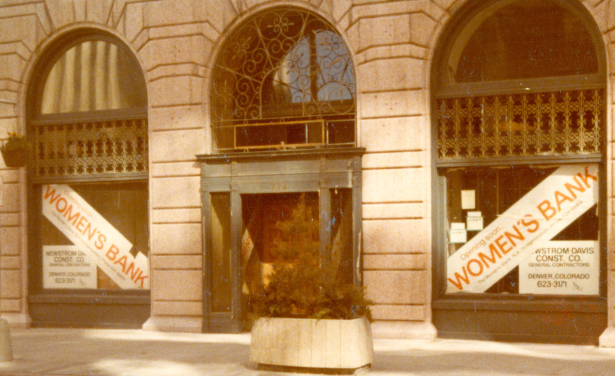
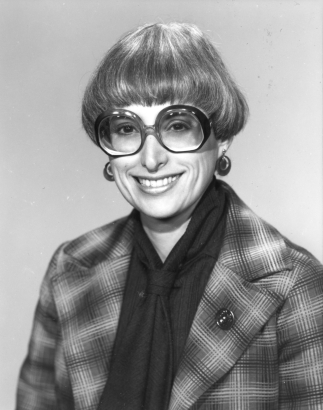

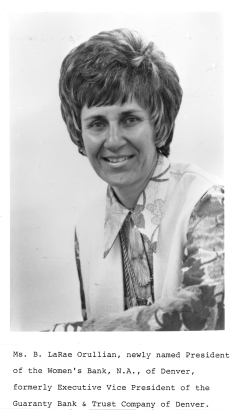
![Advertisement for the International Trust Company, Denver Post, October 24, 1922. [Note: ad contains harmful and racist language]](/sites/history/files/styles/blog_image/public/October_24_1922.jpg?itok=J58BQ4S8)
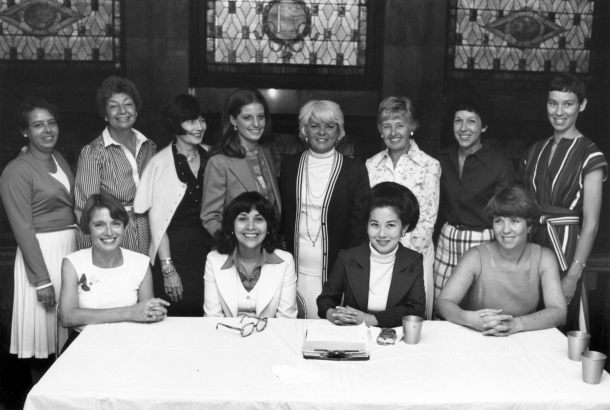

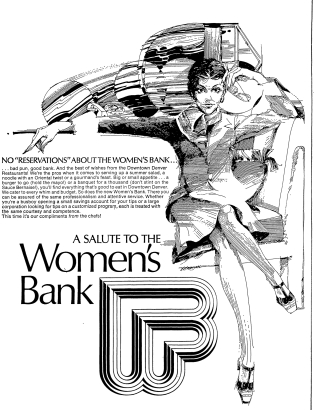

Comments
Really wonderful article and…
Really wonderful article and thank you for clarifying people’s concerns in comments. I will read it to my children ( one 13 year old girl and two younger boys).
Question - did the Women's…
Question - did the Women's Bank include women of color or did it offer banking only to white women? This is genuine curiosity about the history of the bank as I've recently learned many 'Women's' movements lead by white women still excluded women of color. Like women's history month for example...or the suffragist movement.
Looking at the picture, I…
Looking at the picture, I would say so.
The Women's Bank included…
The Women's Bank included women of color. Edna Mosely was on the board. Juereta Smith was instrumental in the formation. Beverly Martinez was of Hispanic background. Another founder was Japanese-American.
I had a checking account in…
I had a checking account in 1974 at 17. No one co signed for me.
That is because the Federal…
That is because the Federal Equal Credit Opportunity Act was enacted in 1974.
I was able to obtain my own checking and savings accounts at the age of 17 - in 1971 - with no co-signers required. That was because I lived in the State of Vermont, which was more progressive than most of the States in the Union. They passed laws allowing for this long before our Federal government stepped in and made it possible in every State.
Either 17, or 18 when I…
Either 17, or 18 when I opened a checking account in my little home town. I do not remember anyone signing for me in 1974 or 1973. But perhaps the bank President did.
Either 17, or 18 when I…
Either 17, or 18 when I opened a checking account in my little home town. I do not remember anyone signing for me in 1974 or 1973. But perhaps the bank President did.
Either 17, or 18 when I…
Either 17, or 18 when I opened a checking account in my little home town. I do not remember anyone signing for me in 1974 or 1973. But perhaps the bank President did.
Either 17, or 18 when I…
Either 17, or 18 when I opened a checking account in my little home town. I do not remember anyone signing for me in 1974 or 1973. But perhaps the bank President did.
Add new comment